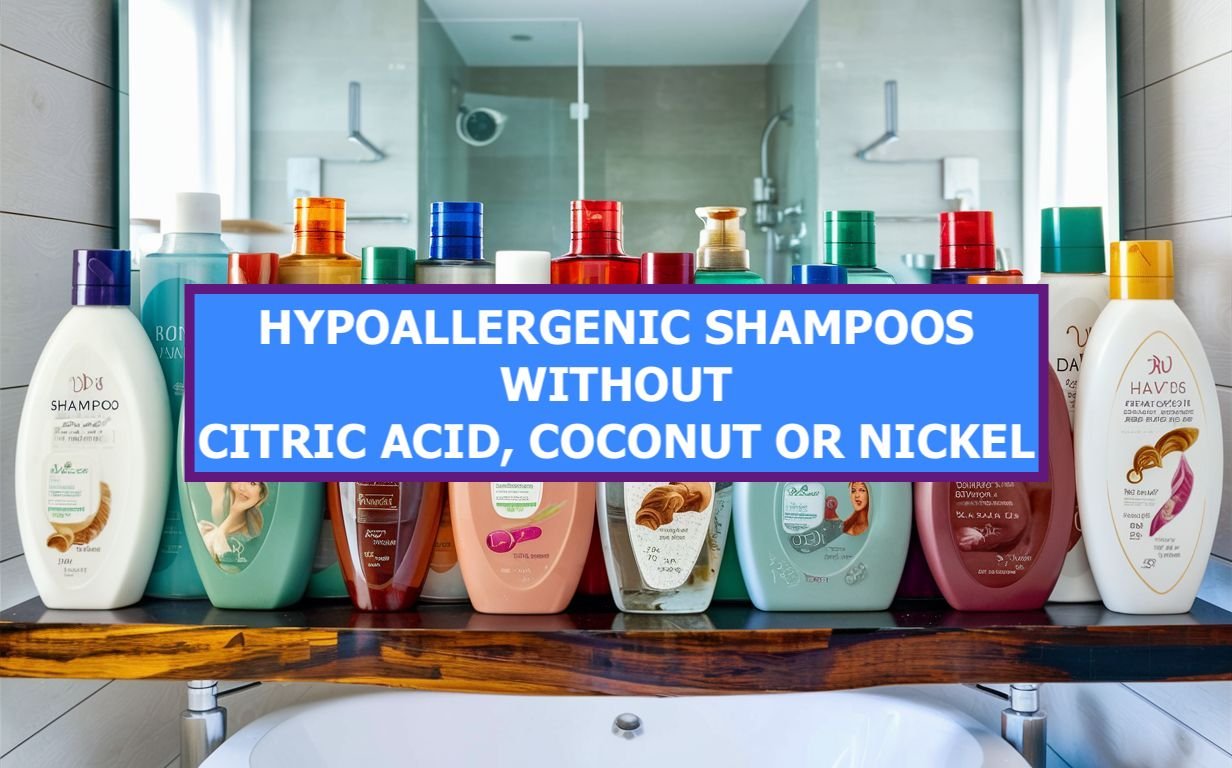Stainless steel cookware is praised for its durability and is a staple in many kitchens. However, it can release small amounts of chromium and nickel into food, which is problematic for individuals with nickel allergies or sensitivities. For them, finding a nickel-free cookware that doesn’t leach nickel is crucial to avoid adverse reactions.
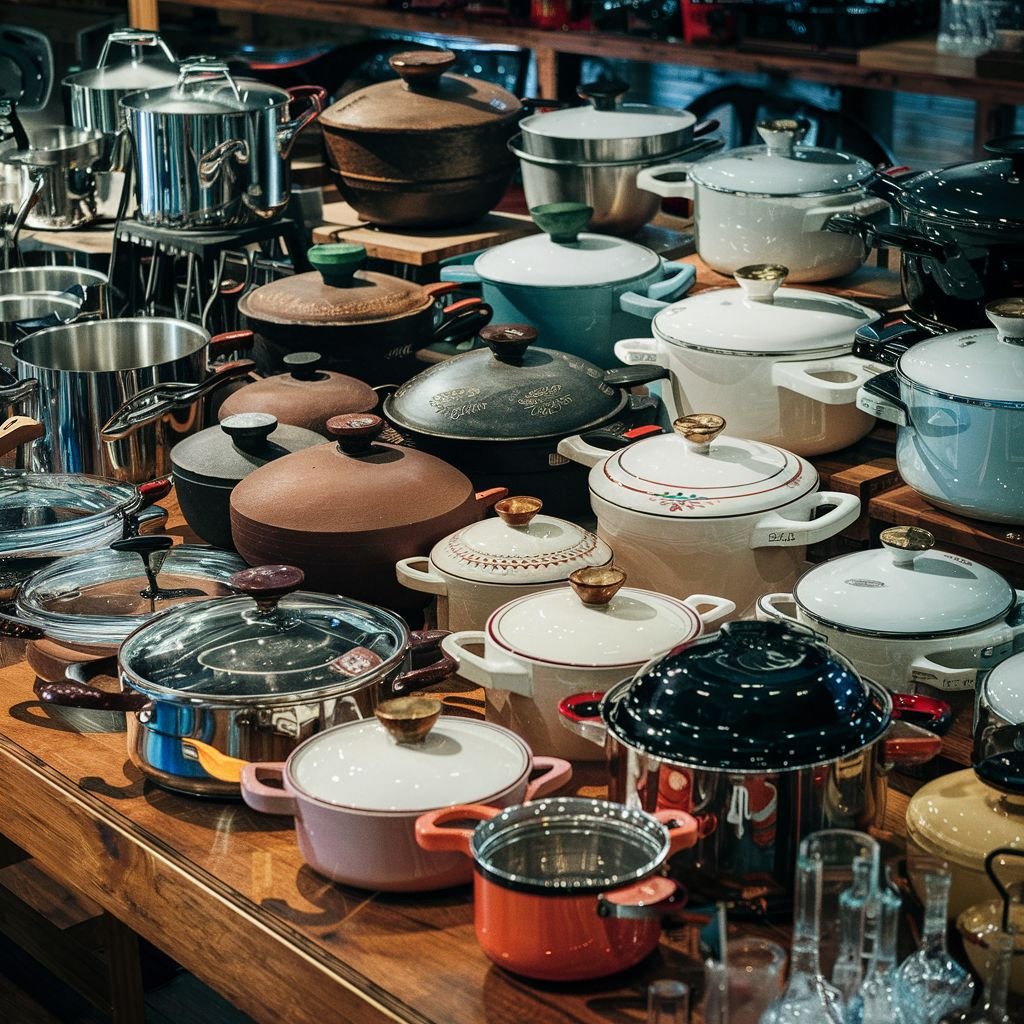
This guide will dive into why nickel in cookware can be an issue and showcase the recommended nickel-free stainless steel cookware brands including pans and pots that will aid you in worry-free, allergy-free lifestyle and cooking.
Understanding why nickel is used in stainless steel cookware requires a deeper look into the properties of stainless steel itself. Stainless steel is an alloy, a blend of metals that combines the strengths of its components to create materials with superior properties. For cookware, these properties include durability, corrosion resistance, and a clean, attractive finish. Here’s a closer look at the key reasons nickel is a critical component in the mix:
Why Do We Use Nickel in Our Kitchen Pots and Pans?
Nickel is mixed with other metals to make a special kind of metal called stainless steel, which is often used for making kitchenware like pots and pans. Let’s break down the simple reasons why nickel is part of this mix:
1. It Helps Fight Off Rust
One of the best things about nickel is that it helps stainless steel resist rust and other types of damage. This means your pots and pans can handle a lot of use, including being washed many times and cooking foods that might be acidic (like tomatoes), without getting ruined. They stay looking good and working well for a longer time.
2. It Makes Them Tougher
When nickel is added to stainless steel, it makes your pots and pans tougher. This toughness is important because it means they can be heated up to high temperatures for cooking without losing their shape. This ensures that your food cooks evenly and that your cookware lasts a long time, giving you good value for your money.
3. It Maintains Quality in All Temperatures
With the help of nickel, stainless steel keeps its quality at any temperature. Whether you’re cooking at high heat or storing leftovers in the fridge, your cookware stays in good shape. This quality is also great for making pots and pans because it means they can be made into different shapes easily and fixed if they ever get damaged.
4. It’s Good for Heat Management
Cooking involves a lot of temperature changes, from very hot when boiling or frying to cold when putting something in the fridge. Nickel ensures that stainless steel can handle these changes without getting damaged. This is essential for cookware that needs to perform well under various cooking conditions.
5. It Makes Cookware Look Attractive
Another nice benefit of nickel is that it makes stainless steel shiny and bright. This shiny appearance makes your kitchen look clean and your cookware seem high-quality. It’s always pleasant to cook with tools that look good, as it makes the whole cooking experience more enjoyable.
However, despite these benefits and important uses, nickel can be a problem for some people who are allergic to it. Even small amounts that might get into food from cookware can cause allergic reactions for these individuals.
Fortunately, there are alternative options for pots and pans that are truly nickel-free. These alternatives ensure that everyone, regardless of their sensitivities, can find cookware that’s safe and comfortable for them to use.
Understanding these reasons, it’s clear why nickel is commonly used in cookware. Yet, the importance of having nickel-free options can’t be overstated for those with allergies, making the kitchen a safer place for everyone.
Best Nickel-Free Stainless Steel Cookware Brands Options
For those who are allergic to nickel or prefer to avoid it for any reason, finding the right cookware can be a bit of a challenge. Nickel is a common component in stainless steel, added to improve its properties. However, the demand for nickel-free options has led to the availability of some alternatives. Here’s a look at what’s out there:
HOMICHEF NICKEL-FREE STAINLESS STEEL COOKWARE WITH 21/0 & 18/0
This brand stands out in the world of nickel-free stainless steel cookware. They offer a range of pots, pans, and complete cookware sets that promise safe, non-toxic cooking surfaces. This hypoallergenic Cookware Set is made from nickel-free stainless steel material, precisely, the 21/0 and 18/0 materials which offers a completely nickel-free cooking experience
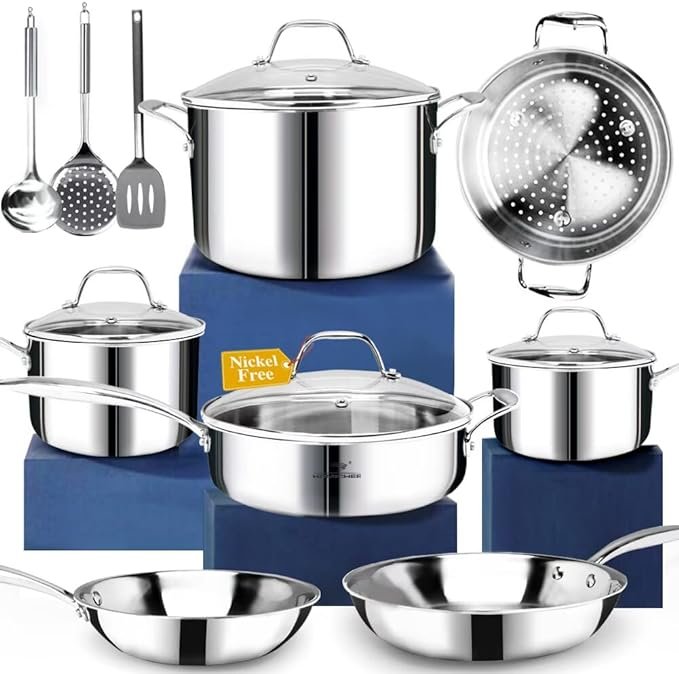
- Material: Whole-clad 3-ply nickel-free stainless steel (it uses a different internal and external stainless steel material for it’s pots and pans; JYH21CT on the inside and 430SS on the outside)
- 3-ply construction: Ensures even heat distribution and better cooking
- No coating: Avoids health risks associated with non-stick coatings
- Natural stick resistance: Achieved through proper seasoning and use
- Additional features:
- Steamer insert included
- Riveted cool handles
- Drip-free pouring rims
- Tempered glass lid
- Compatible with various stovetops and oven/dishwasher safe.
Chantal 21/0 Japanese Steel Cookware (8pc)
Known for their high-quality and durable cookware, Chantal offers this 21/0 (zero nickel) nickel-free stainless steel pots and pans. These products are crafted for longevity and excellent durability and longevity, making them a worthy investment for those serious about nickel-free cooking. It’s fused with Japanese steel, titanium thereby offering a durable, scratch-proof, and no-nickel cookware. It comes in 8pcs, featuring tempered glass lid for an even better hypoallergenic cooking and usage experience.

Features:
- Tempered glass lids for see-through cooking
- Ergonomic, stay-cool handles for comfort and ease of use
- Drip-free pouring rims to reduce spills
- 8-piece set includes:
- 1qt Saucepan with lid
- 2.5qt Pour Spout Saucepan with colander lid
- 6qt Stock Pot with lid (fits fry pan)
- 8″ & 10″ Fry Pans with Ceramic Coating (ceramic coating only on fry pans)
- Unique Japanese Steel:
- Copper infused for even heat distribution
- Titanium added for strength and durability
- Nickel-Free & Magnetic Induction Compatible:
- Ensures healthy cooking and prevents nickel allergic reactions
- Works on all cooktops, including induction
- Stovetop and oven safe to 500°F (lids oven safe to 425°F)
- Eco-Friendly Ceramic Coating (on fry pans only):
- PFOA, PFOS, and PTFE free
Meyer Select Series: Although not as widely available in some regions, the Meyer Select Series includes a few nickel-free options. Their range is more accessible in India, but they do offer some pans internationally that cater to those looking for nickel-free surfaces.
For those whose primary concern is the cooking surface, Viking offers an innovative solution with their 7-ply Titanium cookware set. These pieces feature a titanium cooking surface, ensuring no nickel contact with your food, while the exterior is made from nickel-free stainless steel. However, lids and handles on these items may still contain nickel.

Check out this collection of 430 series nickel-free cookware on Amazon
Considerations When Choosing Nickel-Free Pots and Pans:
When shopping for nickel-free pots and pans, it’s crucial to keep a few things in mind:
- Quality and Durability: Nickel-free pots and pans might not always offer the same level of durability and corrosion resistance as their nickel-containing counterparts. Researching brands that specialize in nickel-free products can help you find cookware that doesn’t compromise on quality.
- Cooking Performance: Some nickel-free metals, like ferritic stainless steel, have different heat conductivity and retention properties. Look for cookware that suits your cooking style and preferences.
- Price: High-quality nickel-free stainless steel cookware can be more expensive due to the specialized materials and manufacturing processes required. Consider this an investment in your health and cooking experience.
- Availability: Finding nickel-free cookware can sometimes be challenging, depending on where you live. Online shopping can offer a wider selection, but it’s always a good idea to verify the product details before making a purchase.
Alternatives to Stainless Steel Cookware: Top 5 Options
Alternatives to Stainless Steel:
While stainless steel cookware is popular for its durability and resistance to corrosion, individuals with nickel allergies or sensitivities need safer alternatives. Here are five excellent materials that serve as great substitutes, each with its unique benefits and considerations.
If finding nickel-free stainless steel cookware proves too difficult, consider other materials that naturally contain no nickel, such as:
1. Cast Iron
Pros:
- Exceptional Heat Retention: Cast iron excels at retaining heat, making it perfect for searing meats and slow-cooking stews.
- Natural Non-Stick Surface: When seasoned properly, cast iron offers a naturally non-stick surface, reducing the need for excess oil.
- Durability: With proper care, cast iron cookware can last generations, often becoming a cherished family heirloom.
Cons:
- Heavy: Cast iron cookware is significantly heavier than other materials, which might be a drawback for some users.
- Maintenance: Requires regular seasoning to maintain its non-stick properties and prevent rust.
- Not Dishwasher Safe: The seasoning can be stripped by dishwasher detergents, requiring manual cleaning and oiling after each use.

Pros:
- Non-Toxic: Ceramic cookware does not contain harmful chemicals and is free from PTFE and PFOA, making it a healthy choice.
- Easy to Clean: Most ceramic cookware is dishwasher safe and easy to clean by hand, thanks to its smooth surface.
- Even Heat Distribution: Provides consistent heat for even cooking, reducing hot spots that can cause food to burn.
Cons:
- Durability: While high-quality ceramic is tough, it can chip or crack if dropped or exposed to rapid temperature changes.
- Price: High-quality ceramic cookware can be on the pricier side compared to other non-stick alternatives.
Buy Ceramic Cookware on Amazon
3. Carbon Steel
Pros:
- Lightweight: Offers many of the benefits of cast iron but is much lighter, making it easier to handle.
- High Heat Tolerance: Carbon steel can withstand very high temperatures, making it ideal for frying and searing.
- Seasonable Surface: Like cast iron, carbon steel can be seasoned to create a natural non-stick surface.
Cons:
- Rust Prone: Without proper seasoning and maintenance, carbon steel can rust easily.
- Not Non-Stick Initially: Requires seasoning and regular use to develop its non-stick properties.
4. Glass
Pros:
- Chemical-Free: Glass cookware is made without harmful chemicals, offering a pure cooking experience.
- Easy to Monitor Cooking: Being transparent, it allows you to watch your food as it cooks without lifting the lid.
- Non-Reactive: Glass does not react with acidic foods, ensuring that your dishes retain their natural flavors.
Cons:
- Breakable: Glass cookware can shatter if dropped or exposed to temperature shocks.
- Heat Distribution: Glass does not conduct heat as well as metal, leading to slower cooking times and potentially uneven heating.
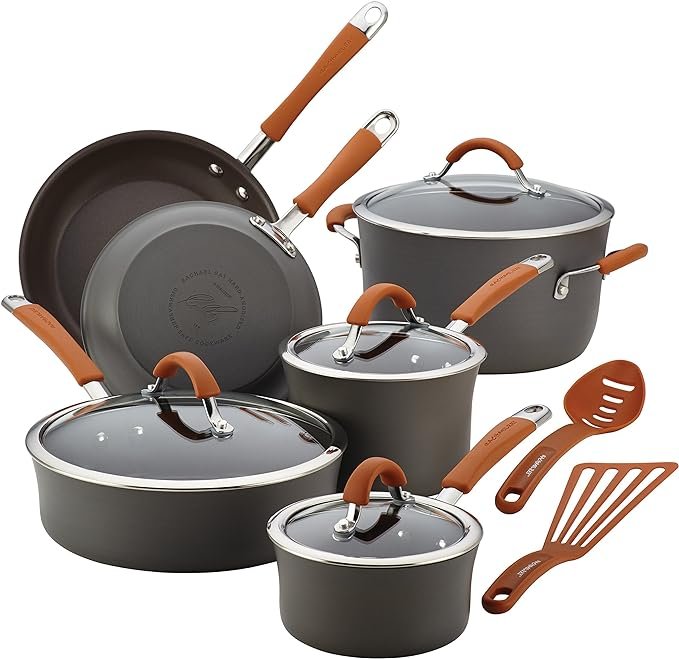
Pros:
- Lightweight and Strong: Offers a good balance of lightweight design and durability, making it easy to handle and long-lasting.
- Excellent Heat Conductivity: Heats up quickly and evenly, reducing cooking times and improving energy efficiency.
- Non-Reactive Coating: The anodization process seals the aluminum, preventing it from reacting with acidic foods.
Cons:
- Scratchable Surface: While durable, the surface can be scratched by metal utensils, requiring careful handling.
- Not Induction Compatible: Without a magnetic base, anodized aluminum cookware cannot be used on induction cooktops. So look out for those with magnetic base when buying.
Each of these alternatives to stainless steel cookware has its own set of advantages and drawbacks. When choosing the best option for your kitchen, consider your cooking habits, maintenance preferences, and any specific health concerns. Whether you’re drawn to the enduring charm of cast iron, the modern appeal of ceramic, or the practicality of carbon steel, there’s a cookware material out there to meet your culinary needs and enhance your cooking experience.
Everything About How to Identify A Nickel-Free Cookware
Choosing nickel-free cookware is crucial for individuals with nickel sensitivities or allergies, but understanding how to identify these products can be challenging. Nickel is commonly used in stainless steel cookware for its durability and resistance to corrosion, but for those affected by nickel, exposure can lead to allergic reactions. Here’s a detailed guide to help you find and select nickel-free cookware with confidence.
1. Understanding Stainless Steel Grades
The key to identifying nickel-free cookware lies in understanding the grading system of stainless steel. Stainless steel is categorized into series and grades, which indicate its composition and characteristics,the standards set by NSF for materials used in food equipment, namely the 200, 300, or 400 series.
Stainless steel 300 Series
The 300 Series includes the 304 and 316 types of stainless steels.
The 304 stainless steel stands out as the most widely-used in cookware. This series includes the well-known 18/10 and 18/8 types of stainless steel, terms that are often seen imprinted on cookware.
These numbers represent the composition of steel and nickel or other materials used in the stainless steel. 18/10 and 18/8 means 18% chromium with 10% or 8% nickel, respectively.
Despite the minor difference in nickel content, both 18/10 and 18/8 stainless steel offer similar performance, durability and use. Ignore all the various marketing claims that suggest significant differences or says otherwise, you can thank us later!
The 304 stainless steel, identified as austenitic, is distinguished by its non-magnetic characteristics, making it a versatile choice beyond cookware, including in jewelry.
Here’s the chemical content of the 304 stainless steel

Next is the 316 and 316L stainless steel, a premium variant of the 304, due to the addition of molybdenum for enhanced corrosion resistance. This enhanced corrosion is the same reason why the 316 is ideal for marine applications and medical tools. The 316 is also widely known as “surgical stainless steel.”
Despite these variations, the everyday cook is unlikely to pick up the differences between 304 and 316 stainless steel in culinary use. Both are capable of delivering quality performance and durability, with 316 steel being notably more corrosion-resistant and, consequently, more costly.

Stainless Steel 200 Series
The 200 series is a cheaper type of stainless steel and this is because the nickel is substituted with manganese. While still deemed safe for food contact, this series is less favored due to its lower corrosion resistance compared to its counterparts.
Stainless Steel 400 Series
The 400 series, particularly the 430 stainless steel, renowned for its negligible nickel content, represented as 18/0 (18% chromium and virtually 0% nickel). This series is widely considered the best for those with nickel sensitivities, offering a solution for nickel-free cookware, pans and tableware.

It’s crucial for consumers, especially those with nickel allergies, to seek out the 18/0 marking to ensure they are choosing nickel-free options. However, it’s important to note that the 400 series might lose some of its luster and corrosion-resistant properties over time due to its composition.
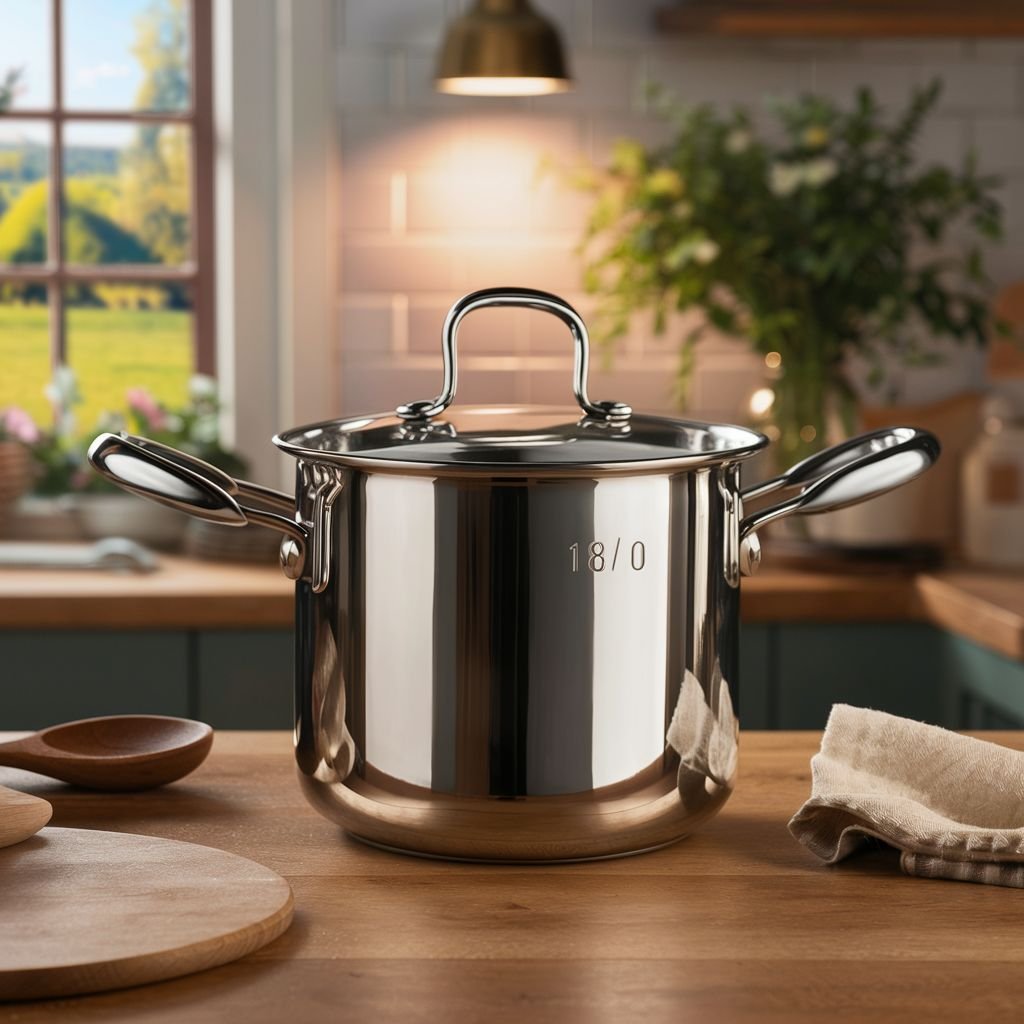
Recap:
- 200 Series: A combination of chromium, nickel, and manganese, known for its affordability but not commonly used in high-quality cookware due to lower corrosion resistance.
- 300 Series: Contains both chromium and nickel; known for its durability and corrosion resistance. This series includes popular grades like 304 and 316, which are not nickel-free.
- 400 Series: Usually chromium only, with negligible or no nickel added. Grades within this series, such as 430, are magnetic and offer good corrosion resistance, making them suitable for a truly nickel-free cookware options.
Remember, To identify nickel-free options, look for cookware made from the 400 series, specifically the 18/0 grade, which indicates 18% chromium and 0% nickel.
2. Reading the Labels
Manufacturers who produce nickel-free cookware often highlight this feature on their products. Look for labels or product descriptions that mention “nickel-free” or “18/0 stainless steel.” Since nickel-free is a unique selling point due to its hypoallergenic properties, brands usually make this information readily accessible to consumers.
3. Check the Manufacturer’s Website or Product Information
If the cookware’s packaging doesn’t explicitly state its nickel content, the manufacturer’s website is the next best resource. Many brands provide detailed specifications of their products online, including the materials used. Product FAQs, customer service inquiries, or technical sheets can also offer insights into whether a product is truly nickel-free.
4. Do The Magnetic Test
A simple home test to gauge the presence of nickel is using a magnet. Stainless steel grades that are magnetic, typically those without nickel, should attract a magnet. This test isn’t foolproof since the magnetic properties can vary based on the alloy’s specific composition, but it can be a helpful preliminary check.
Here’s a very good video showing the magnetic properties for various stainless steel.
5.Inquire Directly
For absolute certainty, contact the manufacturer directly. This can be especially important for individuals with severe nickel allergies. Customer service departments can provide the most accurate and detailed information about the nickel content in their cookware.
6. Consider Alternatives
If identifying nickel-free stainless steel becomes too cumbersome, consider alternative materials known for being nickel-free:
- Cast Iron: Naturally nickel-free, offering excellent heat retention and durability.
- Ceramic: Ceramic pots and pans are indeed nickel-free and provide a non-toxic, non-stick cooking surface without the risk of leaching metals.
- Glass: Completely free of metals, glass cookware is non-reactive and safe for people with nickel allergies.
- Carbon Steel: Similar to cast iron but lighter, carbon steel is an excellent, nickel-free option for high-heat cooking.
- Anodized Aluminum: The anodization process seals the aluminum, preventing any leaching. However, ensure the coating is intact to avoid direct contact with aluminum.
Identifying nickel-free cookware requires a bit of research and understanding of stainless steel grades and manufacturing labels. For those with nickel sensitivities, taking the time to choose the right cookware can significantly improve their health and cooking experience. Always consider reaching out to manufacturers for the most accurate information, and remember that alternative materials can also provide safe and effective cooking solutions.
Is Nickel in Cookware Harmful?
The question of whether nickel in cookware is harmful is not straightforward and depends on individual health conditions, specifically nickel sensitivities or allergies. As discussed in earlier paragraphs, Nickel, a durable, corrosion-resistant metal, is commonly used in the production of stainless steel cookware for its ability to enhance the material’s overall properties. However, is the nickel used in pots, pans, and cutleries harmful?
Nickel Exposure – And What It Is
For most people, the trace amounts of nickel that leach into food from stainless steel cookware are not a cause for concern. The human body requires small amounts of nickel for optimal health, and the levels typically ingested through cooking are generally considered safe. However, the situation is markedly different for individuals with nickel allergies or sensitivities.
Nickel Allergies and Sensitivities
A nickel allergy occurs when the immune system views nickel as a harmful substance, triggering an allergic reaction. Symptoms can range from mild to severe and include skin rashes, itching, and in some cases, gastrointestinal distress if nickel is ingested. For those with nickel sensitivities, even the minute amounts leached from cookware can be problematic, leading to allergic contact dermatitis or systemic nickel allergy syndrome, characterized by skin eruptions, respiratory issues, and gastrointestinal symptoms.
Nickel Leaching Amount
The amount of nickel that leaches from stainless steel cookware depends on several factors, including the acidity of the food and the duration of cooking. Acidic foods, such as tomatoes or lemon juice, can increase nickel leaching, as can longer cooking times. However, it’s important to note that the leaching levels are typically below the thresholds considered harmful for the general population. The real concern lies with individuals who have a known allergy or sensitivity to nickel.
Scientific Perspective
Research indicates that the nickel exposure from stainless steel cookware is minimal and generally within safe consumption levels as defined by health authorities. A study published in the Journal of Agricultural and Food Chemistry found that the amount of nickel leached during cooking is significantly lower than the daily intake considered safe by the World Health Organization. Nevertheless, for someone with a nickel allergy, even these small amounts can provoke an allergic response.
General Cleaning Tips for Cookware
Regardless of the type of cookware you use, maintaining its condition through proper cleaning is crucial for its longevity and performance. Here are some general cleaning tips applicable to most cookware:
- Wash After Cooling: Always allow your cookware to cool before washing to prevent warping or thermal shock, especially in materials sensitive to rapid temperature changes.
- Use Soft Sponges: Opt for non-abrasive sponges or cloths to avoid scratching the surface. For tougher stains, soaking in warm, soapy water usually helps loosen them.
- Avoid Harsh Chemicals: Stick to mild detergents. Harsh chemicals can damage the cookware’s finish and, in some cases, can be harmful if not thoroughly rinsed.
- Dry Immediately: After washing, dry your cookware immediately to prevent water spots and rust formation, especially on iron-based materials.
Special Care for Specific Nickel-free pans and pots
Some types of nickel-free pans and pots require additional care or specific cleaning methods to maintain their functionality and appearance:
Cast Iron
- Avoid Soap and Dishwashers: Traditional cast iron should not be cleaned with soap or placed in the dishwasher as this can strip its seasoning. Instead, wipe it clean with a paper towel or use a stiff brush and hot water.
- Season Regularly: After cleaning, dry it thoroughly, lightly coat it with cooking oil, and heat it on the stove or in the oven to maintain its non-stick surface.
Carbon Steel
- Similar to cast iron, carbon steel should be cleaned without soap and re-seasoned with oil after each wash. It’s also prone to rust, so keeping it dry is paramount.
Ceramic Cookware
- While generally dishwasher safe, hand washing with a soft sponge and mild detergent can prevent the wear of the ceramic coating over time. Avoid using metal utensils or abrasive cleaning tools that can scratch or chip the surface.
Glass Cookware
- Glass is dishwasher safe but can benefit from hand washing to avoid etching or cloudiness over time. For baked-on food, soaking in hot, soapy water before scrubbing gently is effective.
Anodized Aluminum
- Although anodized aluminum is durable and resistant to corrosion, it’s best to hand wash these items to maintain the integrity of the surface. Use a mild detergent and avoid abrasive pads. Not all anodized aluminum cookware is dishwasher safe, as harsh detergents can dull the finish.
Enamel-Coated Cookware
- Enamel coating is easy to clean and generally dishwasher safe, but to preserve its glossy finish, hand washing with a soft sponge is recommended. Avoid using abrasive cleaners or metal scouring pads, which can scratch the surface. For stubborn stains, a baking soda paste can be gently applied.
Taking the time to clean and care for your cookware properly can greatly extend its life and ensure it remains safe and enjoyable to use. While general cleaning practices apply to most cookware, paying attention to the specific needs of materials like cast iron, carbon steel, and ceramic will help maintain their best condition. Remember, the key to longevity is not just in the cooking but also in the cleaning.
Conclusion: Best Nickel-free Pans And Pots
Choosing a nickel-free pot or pan will drastically reduce an individual’s exposure to nickel allergy or SNAS. Opt for 430 series with 18/0 grading imprinted on it, you can do the same for your cups, cutleries and knives too. We hope this article has answered any questions you may have had.
1. What is nickel-free cookware? Nickel-free cookware refers to kitchen pots, pans, and utensils made without nickel, a common allergen for some people. These products are designed for individuals with nickel sensitivities or allergies, offering a safer alternative for cooking without risking allergic reactions.
2. Why should I choose nickel-free stainless steel cookware? Choosing nickel-free stainless steel cookware is essential for those with nickel allergies, as it prevents the leaching of nickel into food during cooking. Additionally, nickel-free options can offer comparable durability and corrosion resistance, making them a healthy and safe choice for any kitchen.
3. How do I identify nickel-free cookware when shopping? To identify nickel-free cookware, look for products labeled as “nickel-free” or made from “18/0” stainless steel, which indicates no nickel content. Additionally, checking the product descriptions or contacting the manufacturer directly can provide assurance of a nickel-free product.
4. Are there any special cleaning methods for nickel-free cookware? While most nickel-free cookware can be cleaned using standard cleaning methods—such as washing with mild detergent and water—some materials, like cast iron and carbon steel, require special care like seasoning and avoiding soap to maintain their non-stick surface.
5. What are the best alternatives to stainless steel cookware for avoiding nickel? Alternatives to stainless steel that are naturally nickel-free include cast iron, ceramic, glass, carbon steel, and anodized aluminum cookware. These materials offer various benefits, such as excellent heat retention, non-reactive surfaces, and durability, making them suitable for different cooking preferences and needs.


